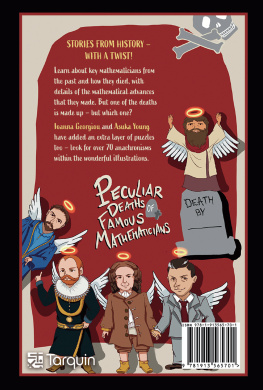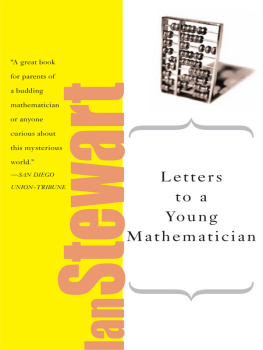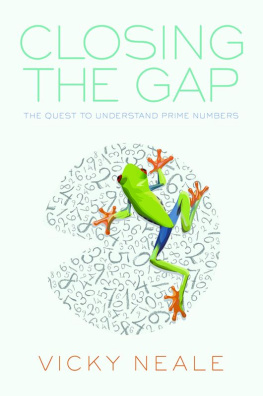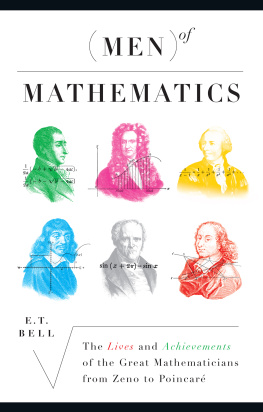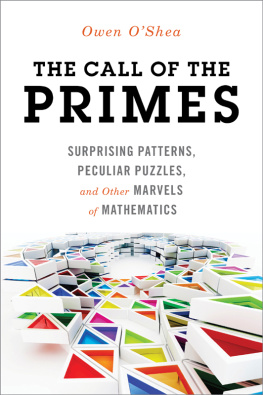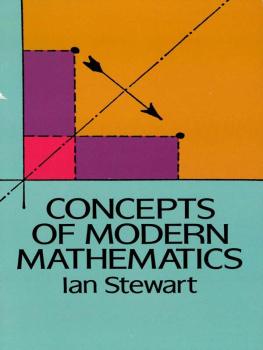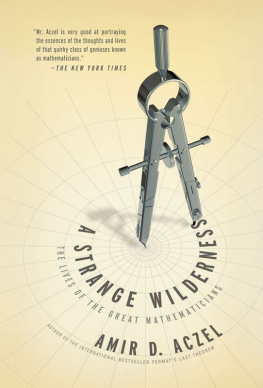PECULIAR
DEATHS OF
FAMOUS
MATHEMATICIANS
PECULIAR
DEATHS OF
FAMOUS
MATHEMATICIANS
IOANNA GEORGIOU
Illustrations by Asuka Young

Publishers Note
I should make a confession: I am a historian by training. No apologies are necessary, its just that people expect the Publisher at Tarquin to be a mathematician. History, though, is the story of everything past and that includes the history of mathematics. Its a fascinating story too uniquely a story of progress. One truth developed from the truths discovered or found by previous generations. And because of the unique nature of proof, less subject to side tracking by belief systems than most disciplines including the other sciences.
So the history of mathematics is one of development as Newton put it, of individuals standing on the shoulders of giants. You, dear reader, are about to read about some of the stories of those giants maybe they will help you on your journey to stand on the shoulders of giants.
But, whatever you get from it, have some fun working out which death is NOT true. And see if you can find 72 anachronisms in the pictures as you go through!
2022 Ioanna Georgiou and Asuka Young
All rights reserved
ISBN (book): 9781913565701
ISBN (ebook): 9781913565718
Design by Karl Hunt
Printed in the UK
Published by Tarquin
Suite 74, 17 Holywell Hill
St Albans AL1 1DT
United Kingdom
www.tarquingroup.com
INTRODUCTION
Mathematicians may have to live a bit more in their heads than most other professionals, save perhaps authors and poets, as that is where most of the magic happens.
Mathematics created or invented (whichever philosophical inclination you follow) often precedes any possible practical applications. Perhaps because of the lack of immediate apparent application of their results, mathematicians are often misunderstood as solitary, unemotional, or just bizarre people. But the mathematical magic does not happen overnight; it is usually work in progress like many other professional occupations. In the meantime, mathematicians get on with living their lives. Like anyone else they maintain a circle of friends, raise families, grow their professional networks and so on. If they are lucky enough to stumble upon something great, they may get a theorem or two named after them.
When the time comes for them to depart, some do so more impressively than others.
In this book we will be telling the life stories of ten mathematicians and take a look at their mathematical worlds, and their findings. Please do bear in mind that the older the story the harder it is to confirm certain details. Here, we go by what seems to have survived throughout the centuries this is what we will take as true. The glue that holds these stories together apart from mathematics is how they have died in the most peculiar ways.
But theres a catch!
Only nine out of the ten mathematicians we talk about in this book have died a peculiar death. One of those ten is a figment of my imagination. Your challenge is to work out which one!
At the end of each chapter, I present you with statistical information about the likelihood of each of those circumstances and deaths. Note that negligible would mean there was substantial difficulty in identifying more than one such case. It is then up to you to make an informed guess. The truth is revealed in the final chapter, where any injustices committed will be acknowledged.
As an additional intellectual snack, most of the illustrations contain an anachronism; an item or symbol misplaced in time. Can you spot the items in the pictures that are ahead of their time? See the notes in the end of the book for answers see if you can find them all!
Special thanks to the colleagues who chatted with me about this book, shared their ideas, stories and insights.

PYTHAGORASS LIFE
Pythagoras lived in the 6th century BC. He was born in Samos, a Greek island in the Aegean Sea. Samos was home to other scientists, engineers and philosophers of the time. Pythagoras is by far the best known, however, and in 1955 one of the towns on the island was renamed Pythagoreio. Before then it was called Tigani, which is the Greek word for pan, possibly due to the shape of the port. I am sure we can agree the more recent option is far better. At that same port there is a special statue to honour Pythagoras, and his namesake theorem, as the formation includes a right-angle triangle.


For the Greeks, the known world was anything surrounding the Mediterranean, the literal meaning of the word being middle of the earth. The sea was easily accessible by ship, scholars, merchants, scientists and many others would travel around, learning from one another, trading, and discovering new habits, practices and materials. Pythagoras was a keen traveller, having visited Egypt, Persia and eventually settling in Italy. He pursued a variety of interests, ranging widely from mathematics to astronomy, music and pottery.
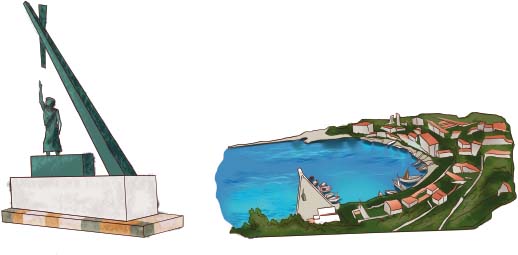



One of his very impressive inventions, albeit perhaps not the most famous one, was the Pythagorean cup (or fair cup). This pottery invention assured that guests around a table were served wine fairly, with no one getting bigger portions. This unique invention, still reproduced today in small local potteries, functions on a principle similar to the straw (plastic or paper one but before it melts in your drink).

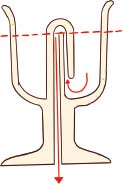
When we drink through a straw, essentially, we remove the air from the straw tube, and the atmospheric pressure acting on the surface of the drink pushes it upwards through the straw. But we need to continue to withdraw the liquid or the air, otherwise the flow of the drink through the straw stops, as it is filled with air again and there is a balance of pressure.
But what would happen if the end of the bent straw was lower than the level of the drink? In that case, we would not be able to stop the flow of the drink through the straw and we would lose all of the liquid. Try it at home with water; it is not dangerous unless you spill it on the floor and you might slip.
Next page
